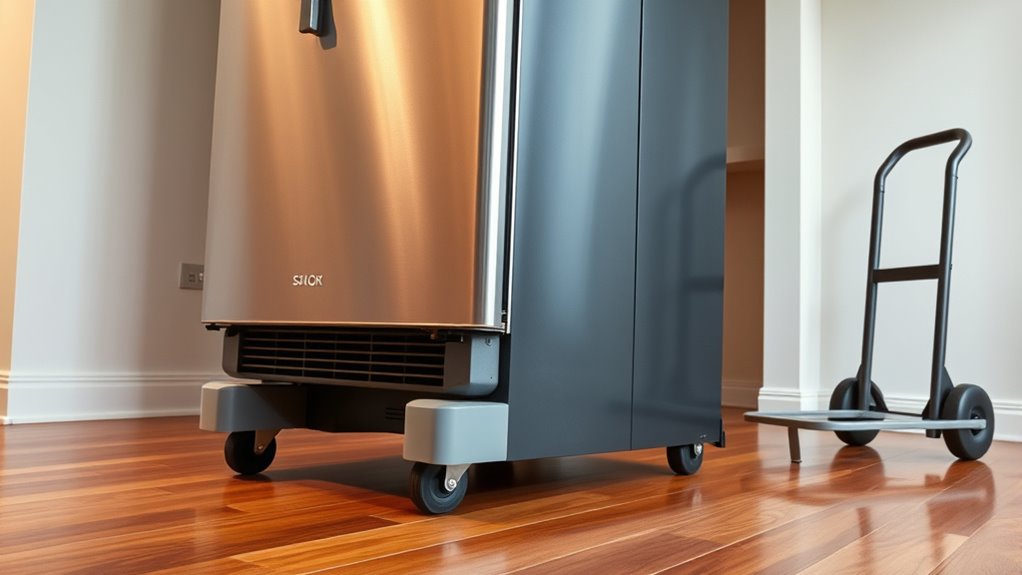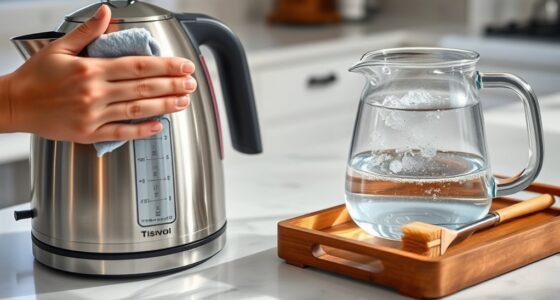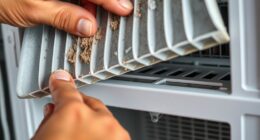To move heavy appliances safely, use the right dollies and sliders designed for load capacity and durable materials like steel or reinforced plastic. Secure appliances with straps, padding, and proper support, and verify they are unplugged, drained, and prepared before moving. Always lift with proper techniques, keep the load balanced, and use equipment with locking wheels to prevent accidents. For detailed tips on choosing, securing, and maneuvering your appliances, keep exploring trusted methods.
Key Takeaways
- Use appropriately rated dollies and sliders with sufficient load capacity to prevent accidents or damage during movement.
- Secure heavy appliances with straps and padding to prevent shifting and surface damage in transit.
- Prepare appliances by unplugging, draining, and protecting wires or delicate parts before moving.
- Maintain steady, controlled force when rolling appliances, supporting long or awkward items with multiple dollies if needed.
- Regularly inspect equipment and surroundings, ensuring safe handling practices and proper securing for efficient, injury-free relocation.
Types of Dollies and Sliders for Heavy Appliances
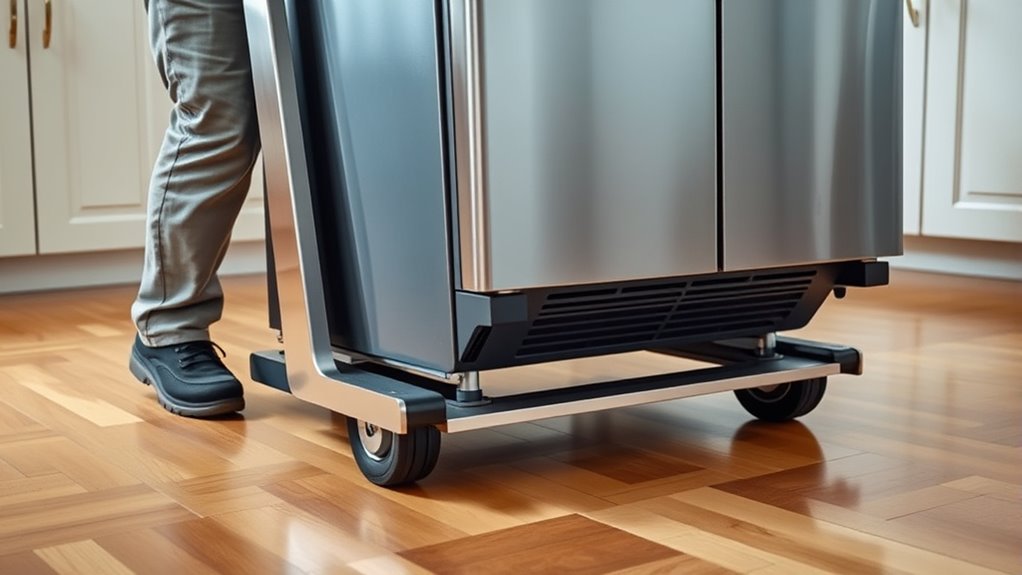
When moving heavy appliances, choosing the right tools can make all the difference. Appliance dollies with steel frames offer strength and durability, making them ideal for hefty loads. They come with nylon ratchet straps to secure your appliance and small solid wheels that roll smoothly on different surfaces. Dual handles provide better control, while protective rub rails prevent damage. Furniture dollies feature flat platforms, often carpeted or padded, and can handle up to 1,000 lbs, perfect for large furniture but not stairs. Hand trucks are compact, upright, and great for lighter loads like small appliances or stacked boxes. 4-wheel dollies give extra stability for uneven or heavy items, and appliance sliders reduce friction, easing the initial move. Using heavy load handling equipment designed specifically for appliances can help prevent injuries and damage during transport. Incorporating ergonomic handling techniques along with these tools can further reduce strain and improve safety during relocation. Combining these tools ensures safer, easier appliance relocation.
Choosing the Right Equipment Based on Weight Capacity
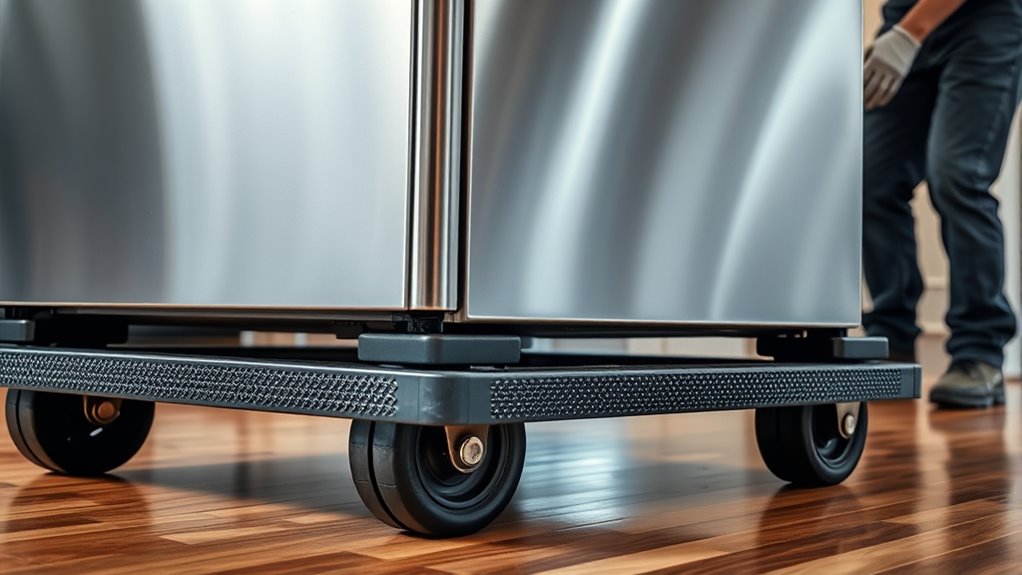
To move heavy appliances safely, you need to match your equipment’s weight capacity to the load you’re handling. Prioritizing durable materials guarantees your tools can withstand the weight and stress involved. Using multiple dollies or support systems can provide extra stability and distribute the weight more evenly. Additionally, selecting equipment with appropriate support wheels ensures enhanced stability during transportation. Proper gear shifting techniques can help in adjusting the equipment for better control and safety during moving procedures. Incorporating proper handling techniques can further prevent accidents and damage during moving procedures.
Match Capacity to Load
Matching the equipment’s capacity to the load is essential for safe and efficient appliance moving. Always select dollies or sliders with capacities exceeding the heaviest appliance by at least 10-20%. This margin guarantees safety and reduces strain on the equipment. For loads over standard ranges, use appliance trucks with additional support wheels to improve stability. Choose appropriately sized trucks for bulky or wide appliances to maintain balance and prevent tipping. Heavy-duty or motorized trucks are ideal for frequent moves or weights above 1,000 lbs. Never operate equipment at or near its maximum capacity for extended periods, as it risks mechanical failure. Always verify both static and dynamic weight ratings to make certain your equipment can handle the load during stationary and in-motion scenarios. Ensuring proper equipment capacity aligns with safety protocols is crucial, as Security vulnerabilities in new technologies can expose businesses to fraud.
Prioritize Durable Materials
Choosing the right equipment based on weight capacity starts with selecting durable materials that can withstand the demands of heavy appliance moves. Steel dollies are ideal for maximum durability, offering exceptional strength and load capacities exceeding 750 lbs. Their fully welded steel joints ensure structural integrity, resisting bending and deformation under extreme weight. Although heavier and more challenging to maneuver, steel dollies excel in harsh conditions. Aluminum dollies provide a lightweight yet strong alternative, supporting up to about 550 lbs, making them easier to handle over long distances. For lighter loads or environments prone to corrosion, plastic and composite dollies are suitable, offering corrosion resistance and ease of cleaning. Prioritizing sturdy materials guarantees safety, reduces breakage risks, and ensures your equipment sustains the rigors of heavy appliance transportation. Additionally, material strength plays a crucial role in selecting the most appropriate dolly for specific moving tasks.
Use Multiple Dollies
When moving extremely heavy appliances, relying on a single dolly often isn’t enough. Using multiple dollies increases the overall weight capacity, allowing you to move bulky items safely without risking tipping or damage. Different dollies have varying weight limits: light-duty (100-200 lbs), heavy-duty (up to 2,000 lbs), and extra-heavy-duty (over 2,000 lbs). Combining dollies spreads the load evenly, reducing stress on each unit and enhancing stability. Always check manufacturer specifications to guarantee you’re not overloading any dolly, as exceeding limits can cause wheel failure or tipping. Strategic placement of multiple dollies helps distribute weight, making the move safer and easier. Proper securing straps on each dolly prevent shifting, ensuring your appliance stays stable during transit. Additionally, weight distribution plays a crucial role in maintaining balance and preventing accidents during the move. To further enhance safety, understanding the different types of dollies can help you select the most appropriate tools for your specific appliance and situation.
Construction Materials and Design Features for Durability
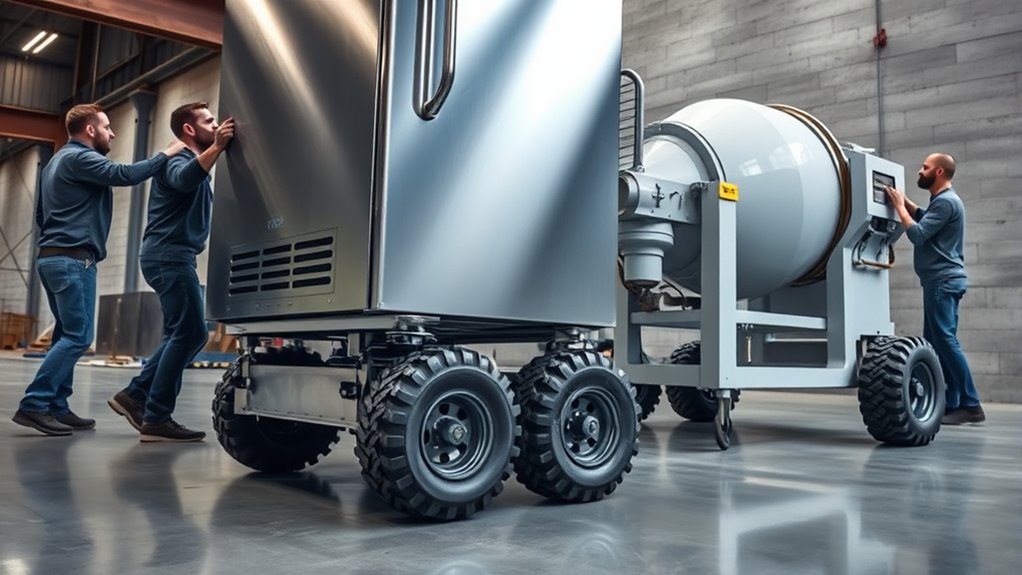
To guarantee long-lasting performance, construction materials and design features for durability focus on selecting robust components and incorporating structural enhancements. For sliders, materials like felt protect floors and enable smooth movement, while plastics such as polyethylene and polypropylene offer durability against wear. Rubber sliders provide grip and cushioning, extending lifespan and floor safety. High-density and ultra-high-molecular-weight polyethylene are ideal for commercial use due to their toughness and low friction. Composite layers combining felt, rubber, and plastic optimize durability and protect flooring. For dollies, steel frameworks deliver high strength, resisting deformation under heavy loads. Aluminum offers a lightweight yet durable option. Polyurethane wheels resist abrasion and chemicals, while pneumatic tires absorb shocks. Reinforced joints, corrosion-resistant coatings, and modular designs further enhance longevity and reliable performance.
Enhancing Maneuverability and Ease of Movement
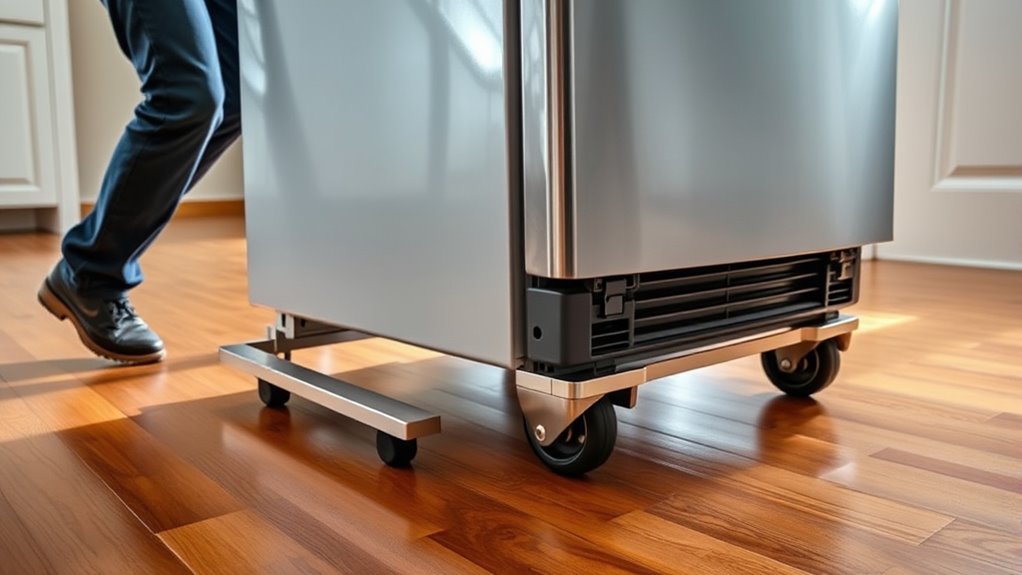
Enhancing maneuverability and ease of movement is key to making heavy appliance relocation safer and more efficient. Furniture sliders reduce friction, so you can move appliances with less effort, lowering the risk of strain or injury. Using dollies and sliders helps avoid heavy lifting, decreasing chances of back injuries or muscle strains. Specialized dollies, like shoulder or stair-climbing models, cut lifting effort by up to 80%, especially on stairs. They evenly distribute weight, preventing sudden shifts that cause accidents. In tight spaces, shoulder dollies allow you to carry items at an angle, while sliders help “walk” heavy pieces around corners. Handles and protective accessories improve control and safety. This combination of tools streamlines movement, making it easier to navigate confined spaces without damage or excessive effort. Being aware of proper techniques and safety precautions can further reduce the risk of injury during heavy appliance movement. Incorporating ergonomic principles into your technique can further enhance safety and efficiency.
Safety Measures to Prevent Damage and Accidents
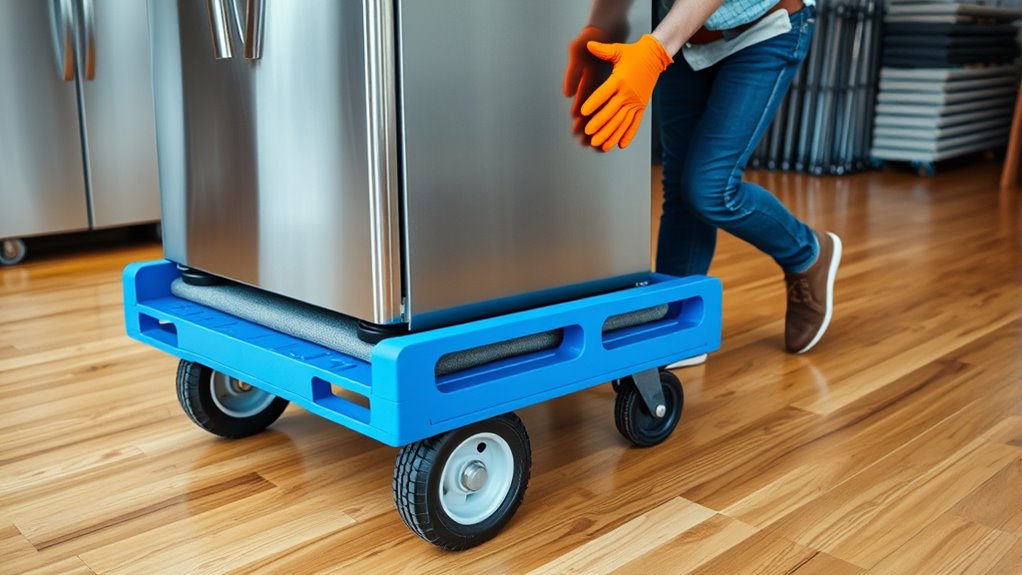
Proper preparation and careful disconnection are essential to prevent damage and guarantee safety during appliance moves. Before lifting, unplug appliances at least 24 hours ahead to allow cooling or defrosting. Shut off water, gas, and electrical lines carefully to avoid leaks or hazards. Drain water pipes to prevent leaks, and secure or tape exposed wires, hoses, and delicate parts to avoid damage. Remove or fasten drawers and shelves with padding. Use the right equipment, like dollies and sliders, to reduce injury and protect surfaces. Properly secure appliances with straps and padding during transit. Ensure heavier items are positioned at the front of the truck for stability. Following these safety measures helps comply with safety standards and minimizes risks for property and personnel. Additionally, inspecting the installation site beforehand can help identify potential obstacles and ensure a smooth move.
Practical Tips for Efficient and Safe Appliance Transport
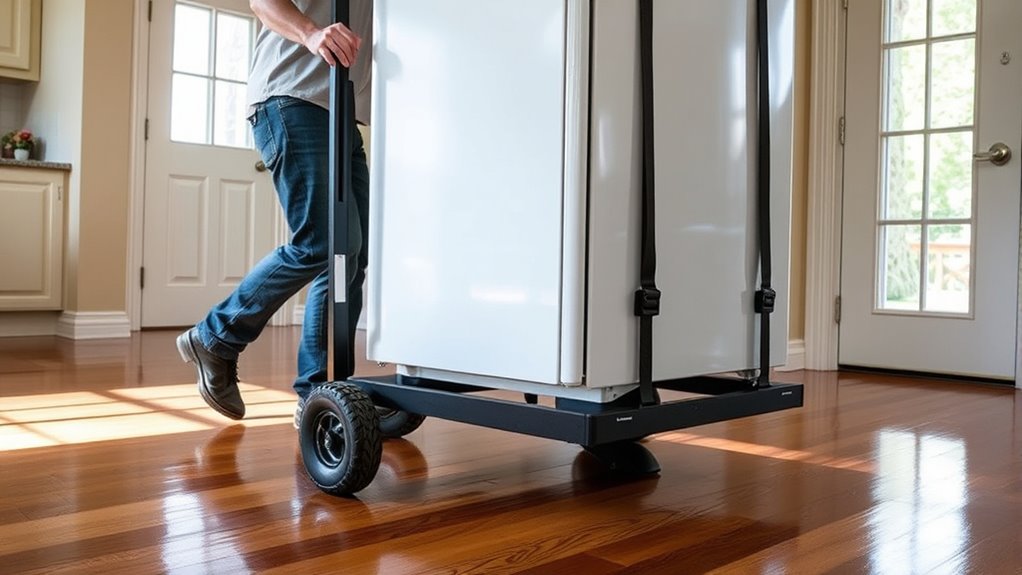
Using the right dollies and sliders can make appliance transportation safer and more efficient. Start by choosing appliance dollies with high load capacity, sturdy steel frames, and locking ratchets to secure your appliances. Use 5-wheeled dollies or roller sliders to distribute weight evenly, reducing tipping risks and ensuring smoother movement on uneven surfaces. Adjust the height of your dollies to lift appliances with high legs, making loading easier. Always secure appliances with straps to prevent shifting during transit. Maintain steady, controlled force while rolling to keep everything balanced. For long or awkward items, support both ends with two dollies. Opt for rubber-coated surfaces and industrial caster wheels to prevent floor damage and improve mobility. Prioritize safety features like locking wheels to avoid accidents during transport. Incorporating proper handling techniques can further enhance safety and efficiency during appliance moves. Additionally, selecting appliance-specific dollies designed for particular weight and size ensures optimal stability and reduces the risk of damage or injury.
Frequently Asked Questions
How Do I Determine the Best Dolly or Slider for My Specific Appliance?
To find the best dolly or slider, first measure your appliance’s weight and dimensions to guarantee compatibility. Consider its shape and stability needs; heavier or uneven items may require a 4-wheel dolly with straps. Think about your space constraints—narrow hallways might need a hand truck. Check the dolly’s weight capacity, wheel type, and safety features like secure straps. Choose one that matches your appliance’s size, weight, and the move’s terrain for safe, efficient transport.
Can Heavy-Duty Dollies Be Used on Uneven or Outdoor Surfaces?
Yes, heavy-duty dollies are designed for uneven or outdoor surfaces. You should choose models with all-terrain wheels, larger sizes, and weather-resistant materials to handle rough terrain effectively. Locking casters and reinforced frames help secure loads and improve stability. Regularly inspect and maintain your dolly to guarantee safety and durability. Picking the right dolly based on your specific outdoor environment will make moving heavy appliances safer and easier.
What Maintenance Is Required to Keep Dollies and Sliders in Optimal Condition?
To keep your dollies and sliders in top shape, you need to give them regular TLC. Picture them gleaming after a thorough cleaning—wheels free of dirt, smooth and rust-free. Lubricate bearings to keep rolling effortlessly, tighten loose bolts, and inspect for cracks or wear. Store them in dry, sheltered spots, and replace worn parts promptly. This routine guarantees your equipment stays reliable, making heavy lifting safer and easier.
Are There Any Accessories That Can Enhance Dolly Stability During Transport?
Yes, you can add accessories like secure straps and harnesses to boost stability during transport. Adjustable spacers and range braces help stabilize uneven or irregularly shaped appliances. Upgrading to larger pneumatic wheels or adding wide base plates distributes weight evenly, reducing tipping risks. Protective padding and covers also enhance grip and cushion impacts, keeping your appliances steady and safe throughout the move. These accessories make your dolly more reliable and secure.
How Do I Safely Lift and Position Appliances Onto Dollies or Sliders?
To safely lift and position appliances onto dollies or sliders, start by removing loose parts and clearing your path. Wear protective gear and assess the appliance’s weight. Use proper technique: bend your knees, keep your back straight, and lift with your legs. Tilt the appliance slightly, slide the dolly or sliders underneath carefully, then secure the appliance with straps. Move slowly and steadily, and ask for help with heavy or bulky items.
Conclusion
With the right sliders and dollies in your hands, you become a skilled navigator guiding heavy appliances safely through tight spaces and over rough terrain. Think of these tools as your trusted steed, sturdy and reliable, helping you conquer the challenge without a scratch or slip-up. Stick to safety tips, choose wisely, and move confidently—your appliances and your back will thank you. Now, go ahead and make moving heavy loads a smooth, controlled dance.
